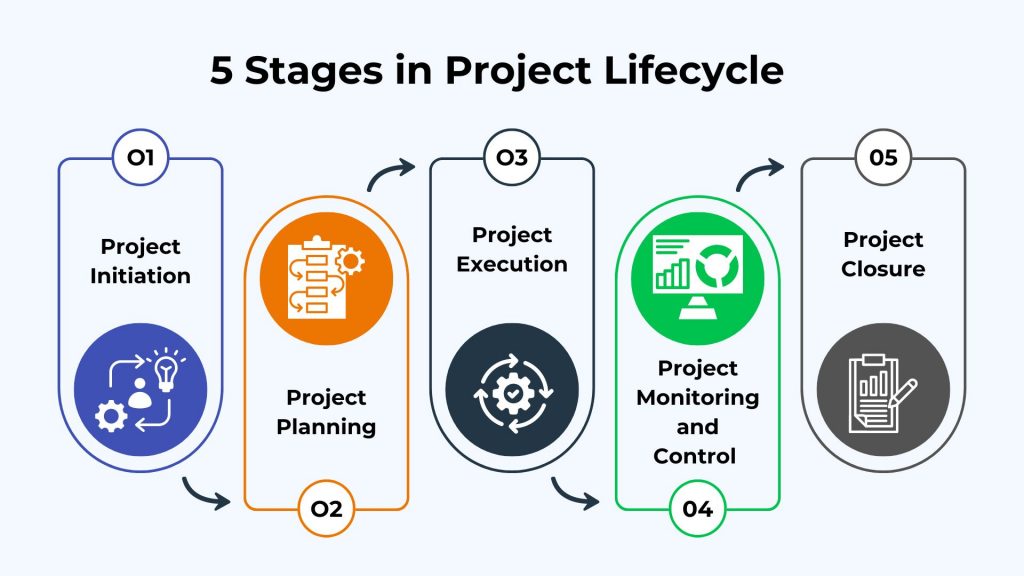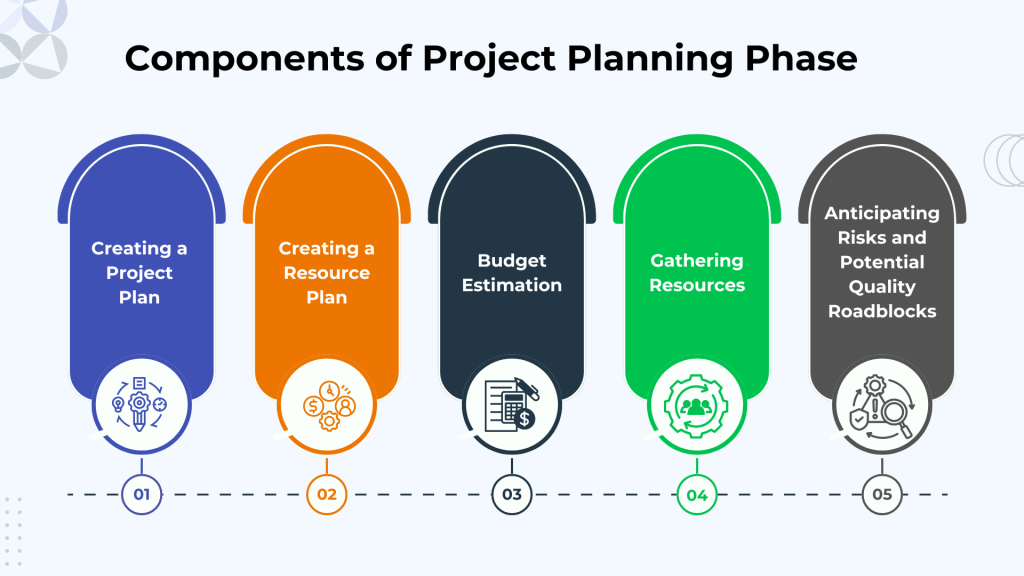
5 Phases of Project Management Life Cycle You Need to Know5 Phases of Project Management Life Cycle You Need to Know
Successful completion of a project is a challenging endeavor. It calls for tasks to meet stakeholder and client requirements; a lot is involved in the project management life cycle process before completion.
No matter what type of project you are working on, comprehensive knowledge about the Project life cycle, phases, or process groups is essential. It keeps your ongoing projects more organized and viable from ideation to completion. In this blog post, we’ll break down the different stages of the project management life cycle, giving you a clear roadmap to navigate your projects from beginning to successful completion.
Table of Contents:
- What is Project Management Life Cycle?
- 5 Phases of Project Management Life Cycle
- Why Process Groups in Project Management?
- Characteristics of a Project Life Cycle
- Important Elements of Project Management Process Groups
- How Project Management Templates Can Help Manage the Project Life Cycle?
- Types of Project Management Life Cycle
- Project Management Lifecycle in Different Industries
- Project Management Lifecycle Example
- Conclusion
What is Project Management Life Cycle?
Project Management Life Cycle (PMLC) refers to the sequence of stages or phases a project undergoes from Initiation to completion. It provides a structured framework for organizing and managing a project’s various tasks, resources, and timelines. The PMLC is essential for ensuring that projects are planned, executed, and closed systematically, focusing on meeting defined objectives within set constraints, such as time, cost, and scope.
The typical phases in the project management lifecycle include Initiation, where the project’s goals, stakeholders, and feasibility are identified; Planning, during which detailed plans concerning resources, timelines, and actions are crafted; Execution, where the plans are put into action and project deliverables are produced; Monitoring and Controlling, to ensure the project stays on track and adjustments are made as necessary; and finally, Closing, where the project is formally completed, deliverables are handed over, and post-project evaluations are conducted.
Each of these stages is critical for the successful completion of a project and provides clear guidelines and checkpoints to ensure that the project’s objectives are met efficiently and effectively.
5 Phases of Project Management Life Cycle

Project Initiation
Project initiation is the first Project Management life cycle phase, where the project starts. It overviews the project and the strategies required to attain desired results. It is the phase where the feasibility and business value of the project are determined.
The project manager starts a meeting to understand the client and stakeholders’ requirements, goals, and objectives. It is essential to go into minute details to understand the project better. Upon deciding to proceed, the project can move on to the next step: assembling a project team.
The Project Charter is considered to be the most important document of any project as it comprises:
- Business vision and mission
- Project goals and benefits
- List of stakeholders
- Scope of the Project
- Project deliverables
- Risks associated with the project
- Project budget and resources

Undertake a Feasibility Study
In the initial stage, it is essential to understand the project’s feasibility. See if the project is viable from the economic, legal, operational, and technical aspects. Identifying problems will help you analyze whether you can solve issues with appropriate solutions.
Identify the Project Scope
Identifying the project scope involves defining the project’s length, breadth, and depth. On the other hand, it’s equally essential to outline functions, deadlines, tasks, features, and services.
Identify the Project Deliverable
The next step is to outline the project deliverables upon identifying the project scope. The project deliverables include defining the product or services needed.
Identification of Project Stakeholders
A thorough identification of project stakeholders is essential. Meeting with team members and experts to identify project stakeholders is better. Documentation of relevant information on stakeholders and their impact on the successful completion of the project is required.
Develop a Business Case
Before developing a business case, check whether the essential pillars of the project, such as feasibility, scope, and identification of stakeholders, are in place. The very next step is to come up with a full-fledged business case.
Creating a statement of work (SoW) and forming a team to wrap up the project initiation phase.
Read out the blog on Project Management Triangle to effectively manage critical project management factors!
Project Planning
A lot of planning related to the project takes place during this phase. On defining project objectives, it is time to develop a project plan for everyone to follow.
The planning phase frames plans that help guide your team through the implementation and closing phases. The program created at this point will help you manage cost, quality, risk, changes, and time.
The project plan should include all the essential details related to the project goals and objectives and how to achieve them. It is the most complex phase in which project managers handle operational requirements, design limitations, and functional requirements.
The project planning phase includes the following components:

Creating a Project Plan
A project plan is a blueprint of the entire project. A well-designed project plan should determine the list of activities, the time frame, dependencies, constraints involved, and potential risks. It assists the project manager in streamlining operations to meet the end objective and tracking progress by making appropriate decisions at the right time.
Creating a Resource Plan
The resource plan provides information about various resource levels required to accomplish a project. A well-documented plan specifies the labor and materials to complete a project. Resources used should have relevant project management expertise.
Budget Estimation
Framing a financial plan helps you to set the budget and deliver project deliverables without exceeding it. The final budget plan lists expenses on material, labor, and equipment. Creating a budget plan will help the team and the project managers monitor and control the costs throughout the Project Management life cycle.
Gathering Resources
Gathering resources is essential to project planning as it helps monitor the project’s quality level. It is not enough to assemble a well-balanced team from internal and external resources. Resources like equipment, money, software solutions, and the workplace should be given to complete the assigned tasks.
Anticipating Risks and Potential Quality Roadblocks
The risk plan will help you identify risks and mitigate them. It will comprise all the potential risks, the order of severity, and preventive actions to track it. Once threats are under control, delivering the project on time is possible, adhering to quality.
Project Execution
Project execution is the phase where project-related processes are implemented, tasks are assigned, and resources are allocated. The method also involves building deliverables and satisfying customer requirements. Project managers or team leaders accomplish the task through resource allocation and keeping the team members focused.
The team involved will create project deliverables and seek to achieve project goals and objectives as outlined in the project plan. This phase determines whether your project will succeed or not. The success of the project mainly depends on the project execution phase. The final project deliverable also takes shape during the project execution phase.
There are a lot of essential things that are taken care of during the execution phase. Listed below are a few of them:

Reporting Progress of a Project
During the project execution phase, it is essential to get regular project updates as they provide the required information and even identify the issues.
Hold Regular Meetings
Before you kick off a project meeting, be clear about the agenda and inform team members of the meeting well in advance. If communication is timely and straightforward, the productivity of ongoing projects and those in the pipeline will not be affected.
Manage Problems
Problems within the project are bound to occur. Issues such as time management, quality management, and a weakening in the team’s morale can hinder the success of a project. So make sure all problems are solved in the beginning.
Project Monitoring and Control
The monitoring and control phase measures the project’s performance and track progress. It is implemented during the execution phase. The main goal of this phase is to check whether everything aligns with the project management plan, especially concerning financial parameters and timelines.
The project manager is responsible for making necessary adjustments related to resource allocation and ensuring that everything is on track. A project manager may conduct review meetings and get regular performance reports to aid this.
Monitoring project activity after the project execution phase will allow the project manager to take corrective actions. Meanwhile, considering the quality of work will also help to make the necessary improvements. Keeping an eye on the budget will help to avoid unnecessary expenses and resources.
Project Closure
With much time and effort invested in project planning, it is often forgotten that the final phase of the project management life cycle is equally important.
The project closure phase represents the final phase of the project management life cycle, also known as the “follow-up” phase. Around this time, the final product is ready for delivery. Here, the main focus of the project manager and the team should be on product release and product delivery. In this stage, all the activities related to the project are wrapped up. The closure phase is not necessarily after a successful completion phase alone. Sometimes, a project may have to be closed due to project failure.
Upon project completion and timely delivery to clients, the project manager’s role is to highlight strengths, list the takeaways of the project, identify the ambiguities, and suggest how they could be rectified for future projects. Taking time to recognize the strengths and weaknesses will help to handle projects with more dedication, which builds the project manager’s credibility.
Once the product is handed to the customers, the documentation is finalized, the project team is disbanded, and the project is closed.
Enroll in Invensis Learning’s Project Management Certification Courses and gain mastery in effective project delivery on Time!
Why Process Groups in Project Management?
For a project to be successful, the project team should:
- Determine suitable processes required to meet the project objectives
- Work to achieve requirements by using a defined approach
- Arrange and maintain appropriate communication and engagement with stakeholders
- Comply with requirements to meet stakeholder needs and expectations
- Balance the critical constraints of scope, schedule, budget, quality, resources, and risk to produce the particular product, service, or result
The project manager and his team are responsible for deciding which processes are appropriate and how to utilize them to get the best out of the project.
The processes in project management are connected and aligned with each other in one way or the other. Modifications and changes performed during one process affect other related processes. For instance, a change in scope typically affects project cost, but it may not affect the level of risk. These process interactions often require compromises among project requirements and objectives. These adjustments could vary from project to project and organization to organization. The role of a project manager is to manage these interactions to meet sponsor, customer, and other stakeholder needs. Sometimes, a process or set of processes may need to be iterated several times before achieving the required outcome.
Characteristics of a Project Life Cycle
The generic project life cycle structure commonly exhibits the following characteristics:
- At the start, cost, and staffing levels are low and reach a peak when the work is in progress. It again starts to drop rapidly as the project begins to halt
- The typical cost and staffing curve do not apply to all projects. Considerable expenses secure essential resources early in their life cycle
- Risk and uncertainty are at their peak at the beginning of the project. These factors drop over the project’s life cycle as decisions are reached and deliverables are accepted
- The ability to affect the final product of the project without impacting the cost drastically is highest at the start of the project. It decreases as the project advances toward completion. It is clear from Figure 2 that the cost of making new changes and rectifying errors increases as the project approaches completion
These features are present almost in all project life cycles but in different ways or degrees. The intent of the adaptive life cycles lies particularly with keeping stakeholder influences higher and the costs of changes lower throughout the life cycle than in predictive life cycles.
Let’s take a look at how knowledge of the project life cycle benefits an organization:
- It helps professional services teams to be more proficient and profitable
- The project life cycle helps the organization
- It makes the flow of communication easier
- The knowledge emphasizes reporting and examining previous projects

Important Elements of Project Management Process Groups
There are some project management processes, apart from the five above, which run through all of the phases:
- Phase Management: As the name suggests, a project manager’s job is to satisfy the conditions for completing each phase and starting the next one. Before exiting a phase, he must be fully aware of the deliverables that must be completed and accepted by the concerned stakeholders.
- Communication: Communication plays an integral part in any project. A project manager must ensure communication responsibilities are clear with team members, the project board, stakeholders, and related third parties. Insufficient or improper communication is a common problem area for projects and needs to be appropriately addressed.
- Procurement: This is a specialist area. Some projects, like the ones involving information technology, hire third parties to manage purchasing or any other department. Efficiently managing these third parties is an essential task for a project manager.
- Integration: Many projects impact their department or area and other business areas. As a project manager, one must ensure that he reflects on how the project will interface with other projects or functions or affect other businesses.
Choose from top globally recognized Project Management Courses offered by Invensis Learning
How Project Management Templates Can Help Manage the Project Lifecycle?
Project management templates are pre-defined formats or structures used to capture, track, and communicate various aspects of a project. Leveraging these templates can streamline the Project Management Life Cycle (PMLC) in multiple ways:
Consistency and Standardization
- Ensures that all projects follow a consistent format, making it easier for team members and stakeholders to understand the project’s status, requirements, and outcomes
- Facilitates adopting best practices across projects and reduces the likelihood of missing critical steps or information
Efficiency
- Reduces the time spent creating documents from scratch, enabling project managers to focus more on execution and decision-making
- Offers quick reference points and checklists to ensure all phases of the PMLC are addressed
Improved Communication
- Provides clear and structured formats for project updates, making it easier to communicate progress, risks, and changes to stakeholders
- Enhances transparency and ensures everyone is on the same page
Risk Mitigation
- Templates often come with sections for risk identification and mitigation strategies, ensuring that potential issues are addressed proactively
- Provides a structured way to capture lessons learned, which can be useful for future projects
Resource Management
- Templates can include sections for resource allocation, timelines, and budgets, helping track and optimize resource use throughout the project
Documentation and Archiving
- Ensures that all critical information, decisions, and changes are documented, providing a historical record for future reference or audits
- Simplifies handing over the project or integrating new team members by offering a clear record of project details
Project management templates serve as a blueprint for managing and executing projects, ensuring no critical aspect is overlooked. By using them consistently, organizations can enhance the effectiveness of their project management processes, leading to better project outcomes and increased stakeholder satisfaction.
Types of Project Management Life Cycle
There are several types of project management life cycles, each with its own steps and processes. Some of the most common types include:
- Waterfall: This is a linear, sequential approach in which each project phase must be completed before moving on to the next. Waterfall is often used for projects with well-defined requirements and a clear end goal.
- Agile: This flexible, iterative approach emphasizes rapid development and continuous improvement. It is often used for projects with rapidly changing requirements or unclear end goals.
- Iterative: This is a cyclical approach that involves repeating the project life cycle multiple times to refine and improve the project. It is often used for projects with complex requirements or high uncertainty.
- Hybrid: This approach combines elements of two or more project management life cycle types. It is often used for projects that have characteristics of different types of projects and require a tailored approach.
- Lean: This approach is based on the principles of Lean manufacturing, it emphasizes on reducing waste, maximizing value, and empowering the team.
- Kanban: This approach is a scheduling system for lean manufacturing and just-in-time manufacturing (JIT). Kanban is a visual process-management system that tells team members what to produce when, and how much to produce.
Each type of project management life cycle has its own advantages and disadvantages, so choosing the right one for your specific project is important.
Project Management Lifecycle in Different Industries
The project management life cycle varies across different industries due to each sector’s unique characteristics, requirements, and challenges. Each industry adapts the project life cycle to meet its specific goals and operational needs, ensuring effective project execution and successful outcomes. Here’s an overview of how the project management life cycle is applied in various industries:
Construction Industry
The project life cycle in the construction industry typically includes the following stages:
- Conceptualization and planning (defining project goals and objectives, developing a project plan and schedule, identifying and allocating resources)
- Design and engineering (creating detailed design plans and specifications, obtaining necessary permits and approvals)
- Procurement and construction (soliciting bids and awarding contracts, managing the construction process)
- Closeout and commissioning (completing final inspections and tests, obtaining final approvals and certificates, conducting a project review, and identifying lessons learned)
Software Development Industry
In software development, the project life cycle typically includes the following stages:
- Planning and analysis (defining project goals and objectives, identifying project scope and constraints, creating a project plan and schedule)
- Design and development (creating detailed design plans and specifications, developing and testing software)
- Implementation and maintenance (deploying the software, providing ongoing support and maintenance)
- Closeout and review (conducting a project review, identifying lessons learned, conducting post-implementation evaluations)
Product Development Industry
The project life cycle in the product development industry typically includes the following stages:
- Research and Conceptualization (Defining the problem, researching solutions, creating a concept)
- Design and Development (Creating detailed design plans and specifications, prototyping and testing)
- Production and Distribution (Manufacturing and delivering the product to customers)
- Closeout and Review (Evaluating the product, identifying lessons learned, conducting post-launch evaluations)
Manufacturing Industry
In this industry, the project management life cycle includes the phases of product design, process design, equipment design, implementation, and maintenance. This process involves coordinating the efforts of engineers, production workers, and management to design, build, and maintain manufacturing equipment and processes according to the project’s specifications and budget.
Pharmaceutical Industry
The project management lifecycle in this industry includes the phases of discovery, research, development, testing, and launch. This process involves coordinating the efforts of scientists, medical researchers, and regulatory affairs to develop, test and launch a new drug.
IT Industry
The project management lifecycle in this industry includes the phases of initiation, planning, execution, monitoring and controlling, and closing. This process involves coordinating the efforts of IT professionals, such as network administrators, software developers, and IT managers, to design, implement, and maintain IT systems and infrastructure.
The project life cycle can vary depending on the industry and the specific project. Still, these examples give you an idea of the stages and activities typically included in different projects.
Project Management Lifecycle Example
One example of a project management lifecycle is the construction of a new hospital.
- Initiation: The hospital board initiates the project, which identifies the need for a new facility to meet the community’s growing healthcare needs. A project manager is appointed to lead the project, and a project charter is developed outlining the project’s objectives, scope, and stakeholders.
- Planning: The project manager works with architects and engineers to design the new hospital, considering patient flow, medical equipment needs, and building codes. A detailed project plan is developed outlining the schedule, budget, and resources required for the project.
- Execution: The project manager coordinates the efforts of the construction team, including workers, subcontractors, and suppliers, to build the new hospital. Regular progress meetings ensure the project stays on schedule and within budget.
- Monitoring and Controlling: The project manager closely monitors the project’s progress and makes adjustments as necessary to keep the project on track. This includes identifying and addressing any risks or issues that may arise.
- Closing: The project manager reviews the project to ensure that all objectives have been met and that the new hospital is ready for operation. The project is formally closed, and the project team is disbanded.
Throughout the project, the project manager communicates regularly with the hospital board and other stakeholders to inform them of the project’s progress and address any concerns they may have.
Conclusion
Professional project managers must be familiar with the practice and execution of five main process groups. The only way to make oneself most worthy or valuable to a company is to know how to initiate, plan, execute, monitor, and close a project. As the project manager undertakes and leads more projects, he/she gains enough experience to understand what works best for the progress and growth of the company. Give yourself a chance to grow in your Project Management career with PMP certification training and gain the best skills and practices to manage projects.
Know more about Project Management best practices through Invensis Learning’s Project Management certification training on PMP Online Training, CAPM Certification Prep, Prince2 Course, Project Management Fundamentals, etc















Well explained and informed. I have gained a lot!!
Highly appreciated
Looking for an affordable way to enhance your well-being? Find the advantages of [URL=https://yourdirectpt.com/pill/doxycycline/ – doxycycline on line[/URL – , optimal for those seeking results without compromising financial ease.
To secure the best price on lasix pills order , visit our site.
Para aquellos preguntandose https://swanpercussion.com/item/lasix/ , es importante comprender que esta planta medicinal se utiliza en la sanacion ayurvedica para mejorar la condicion femenina.
Venture into the realm of effective ED solutions with [URL=https://columbiainnastoria.com/pill/fildena/ – fildena[/URL – , available online.